Wildlife enthusiasts throughout the world have their hearts and minds charmed by the wildebeest migration in Kenya’s Masai Mara National Reserve.
Certainly, it is a great experience to watch millions of wildebeests, antelopes, and zebras crossing the vast Serengeti-Masai Mara ecosystem.
But why do these animals go on such a strenuous and dangerous journey every year?
In this article, we shall look at the reasons behind this instinctual nudge to migrate unpacking the complex tapestry of nature’s cycles as well as survival mechanisms for these amazing creatures.
The age-old pursuit of sustenance

This primal urge propels them towards the south where it is still wet enough to drive fresh growth of new pasture. As Tanzania’s southern regions continue to dry up during the dry season, lush grasslands of Serengeti turn into deserts hence prompting wildebeests and other migratory species to search for greener pastures.
This deep-rooted animalistic instinct that follows rain patterns leading to new foliage is inscribed within their DNA. This kind of survival has been shaped over numerous generations allowing them to continue living even in an ever-changing natural world which sometimes can be harsh.
Luring waters

Water is the lifeblood of any ecosystem, and its availability plays a crucial role in dictating the migratory patterns of the wildebeest and their companions. This forces them to set off on a long journey from South Serengeti as water sources diminish during dry seasons.
The lure towards Kenya’s Masai Mara region that has replenished water sources acts like a magnetism which is irresistible thereby driving huge herds to the watering rivers and streams that sustain their lives.
In this way, migration becomes an inevitable consequence resulting from this inseparable relationship between water and survival instincts reflected on these animals’ route across vast savannah landscapes.
Birthing grounds and calving season- The Cycle of Life

For many species participating in the wildebeest migration, it is not only about finding food and water; it is also about ensuring that there are generations to come. The Southern Serengeti plains are rich in nutrients with lush vegetation that become great birthing grounds for thousands of wildebeests & other migrators during calving time.
From late January through mid-March hundreds of thousands of calves belonging to this species are born in such a short period. The calving season triggers the migration as herds move towards areas that would be more comfortable for their young ones, and this ensures that their species will continue for many generations.
Predator Avoidance through Safety in Numbers

People are likely to think of wildebeest migrations as dangerous. However, such thought is the complete opposite since the group size is its own form of safety. Wildebeests and others moving with them reduce predation risks by engulfing and confusing potential attackers whenever they gather in huge numbers.
These migrating herds are so large that they can often deter powerful predators such as lions, cheetahs, or hyenas. This multitude of herds causes uncertainty and disorder which make it difficult for predatory wild animals to single out one individual amongst them for attack.
This pattern shows how well these species have adapted over time to survive regular exposure to predators.
The Wild Beast Migration: Nature’s Guiding Force

Despite how the wildebeest migration reasons may appear reasonable and simple, it is their innate migratory instinct that propels this phenomenon. This natural behavior, which is inborn and adaptive, has not failed to amaze me.
The wildebeest and other migrant species possess an inherent understanding of the cyclic patterns of their environment, detecting subtle cues and triggers for triggering off their journeys.
Whether it’s the change in seasons, the availability of resources, or the primitive urge to propagate their own generation’s survival – this instinct is nature’s pilotage directing these creatures on their epic journey across the immense savannah landscapes.
The Interconnected Web of Life

Ultimately, the Wildebeest migration is more than just a fascinating occurrence; it is an intricate web of interconnecting lives that maintain balance within Serengeti-Mara ecosystems as a whole. Everything about this migration from predators depending on migrating herds for food to scavengers who feed on leftovers plays a critical role in maintaining equilibrium within this amazing environment.
This recurrent migration is a source of natural distribution, grazing field refill mechanism, and manure spreading, all ensuring rejuvenation and regeneration of the ecosystem to make it survive for many years.
Nature’s intricate tapestry is shown when we observe millions of animals moving, where each thread is intricately interwoven. The wildebeest migration is not just a spectacle; it’s a living embodiment of the resilience, adaptability, and interconnectedness of life itself.
The eternal search for food supplies, the quest for freshwater sources, the continuation of lineage, or basic survival instinct are some among countless reasons behind wildebeest migration. Understanding this can help in appreciating the workings of nature and how these amazing animals have survived through their remarkable resiliency.
Therefore, while you hear the hooves sound like thundering rain and see dust surrounding migrating herds remember you are witnessing an everlasting and breathtaking cycle that has enabled life to exist in the Serengeti-Masai Mara ecosystem for generations upon generations.





